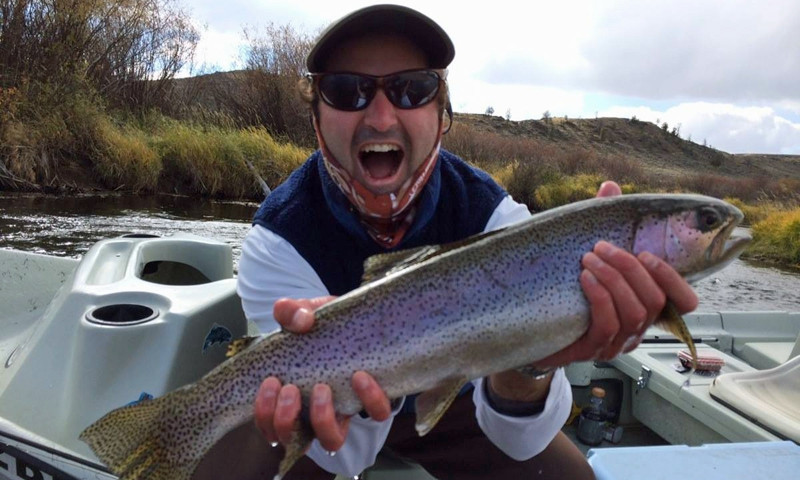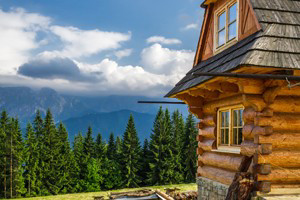What to Know Before You Hit the Rivers
Fly fishing in Jackson Hole isn't just about catching trout—it's about finally slowing down for once. The Snake River at sunrise is quiet in a way that gets your attention. Cold air, sharp shadows through the cottonwoods, and if you're lucky, the telltale ripple of a rising trout.
If you're just getting started, here's the good news: you don't need to be a pro to enjoy it. You just need an experienced fly fishing guide (or good advice from a local Jackson fly shop), a little patience, and a willingness to stand in cold water for a shot at something wild. This isn't bobber-on-a-pond fishing. It's active, it's focused, and yeah—it'll humble you in a good way.
Whether you're picking up a fly rod for the first time or just brushing off the rust, this planner walks you through the basics and gives you a feel for what a real day on the river looks like.
You might hook a few. You might not. Either way, it beats staring at a screen.
Jackson Hole Fly Fishing Basics
Jackson Hole is the real deal. Cold, clean water. Big scenery. And trout that still eat dry flies like it's their job.
Set in the Greater Yellowstone Ecosystem, this place offers wild fish in wild places—and enough access points that you don't need to be a local to make it work.
But here's the kicker: fly fishing isn't some rare hobby around here—it's a way of life. Locals fish before work, after work, and pretty much any chance they get. It's not fancy. It's just what people do.
Why anglers keep coming back:
- Native Cutthroat Trout – They've lived here forever, and they're still hungry for dry flies.
- Easy Public Access – No secret handshake required. Plenty of spots you can walk right into.
- Top-Tier Guides – If you want help, you've got options. Many Jackson Hole fishing guides have been teaching and guiding for decades.
- Fish All Year – Yes, even when there's snow on the ground.
- Mix It Up – Drift trips, small streams, alpine lakes—it's all here.
Whether you're casting for the first time or the hundredth, Jackson Hole delivers.
What You'll Be Catching
Let's start with the stars of the show: the trout. Jackson Hole is a multi-species destination, but the real headliner is the Snake River Fine-Spotted Cutthroat Trout—a native fish that locals speak of with the reverence usually reserved for hometown heroes.
Snake River Cutthroat Trout
- Behavior: Willing risers, especially to dry flies
- Look for: Small black spots scattered along a golden body
- Best tactic: Hopper-dropper rigs, stoneflies, or attractor patterns like the Chubby Chernobyl, Royal Wulff or Double Humpy.
Brown and Rainbow Trout
- Found in: Slower water, deeper pools, cooler tailwaters
- Best tactic: Streamers in the fall, nymphs year-round
- Behavior: Smart, strong, sometimes spooky
Brook Trout
- Tiny but feisty, often found in high-elevation creeks and ponds
- Gorgeous colors—red belly, white-edged fins, dark vermiculation
- Behavior: Scrappy. Great fun on light gear.
Mountain Whitefish
- Underrated fighter
- Eats small nymphs, often found in the same runs as trout
Not every fish is a trophy, but every fish gives you something to remember—whether it's a hard fight or a clean escape.
Gearing Up Without Going Overboard
Keep it simple initially. You don't need to dress like an extra in A River Runs Through It to get started.
- Spring/Fall: Breathable waders
- Summer: Wet-wade—neoprene socks + solid sandals or boots
- Boots: Rubber soles only (studs banned in boats)
- Sunglasses: Polarized are mandatory. Trust me.
- Hat & Sunscreen: Yes, even on cloudy days (UV-rays are way more intense at this altitude)
Local Tip: Most guided trips come with all the gear you need—rod, reel, flies, even waders. Double-check what's included when you book. Not sure you're all-in on fly fishing yet? Let the guide supply the setup. Try before you buy.
The Basics:
- Rod: 4- or 5-weight rod, 8'6" to 9' is ideal for beginners
- Reel: Something simple with a decent drag system
- Line: Weight-forward floating line
- Leader & Tippet: 9-foot 4X or 5X for general trout fishing
Flies:
- Dry Flies: Elk Hair Caddis, Parachute Adams, Purple Haze
- Nymphs: Pheasant Tail, Zebra Midge, Pat's Rubber Legs
- Streamers: Woolly Bugger, Sculpzilla, Mini-Dungeon
Local wisdom: Walk into JD High Country Outfitters or Snake River Anglers, explain where you're going, and let them build you a small, seasonally-appropriate fly box. The guides love helping beginners.
Casting, Knotting & Reading Water: How to Start
You don't need to be athletic. You need to be patient.
Casting:
Start with short, clean casts. Focus on line control, not distance.
Three Knots to Know:
- Clinch Knot: Fly to tippet
- Surgeon's Knot: Leader to tippet
- Loop-to-Loop: Leader to fly line
Practice: Cast in your backyard. It helps.
Reading the River
Trout aren't random. They hold in places where food comes to them:
- Seams between fast and slow water
- Undercut banks
- Deep pools below riffles
- Foam lines (foam is home)
Fishing sharpens how you notice things. Over time, it's not just the fish you're watching—but the way light moves on the water, how currents shift, how everything connects.
Where to Fish in Jackson Hole
You don't have to bushwhack to find fish. Here are some go-to spots:
Snake River
- Best for: Drift trips and big open water
- Access: Wilson Bridge, Moose Landing, South Park. The Snake is best accessed by a drift boat. Book a Jackson Hole Fly Fishing Guide to truly experience it.
- Top flies: Chubbies, hoppers, nymph droppers
Gros Ventre River
- Best for: Wading and easy walk-in spots
- Access: Near Kelly and up Gros Ventre Road
- Flies: Small dries and beadhead nymphs
Flat Creek (National Elk Refuge)
- Best for: Sight fishing cutthroat
- Access: Just outside Jackson - Season runs August 1 through October 31.
- Tip: This is the PhD program of Jackson Hole fishing. Bring your A-game—these fish are spooky
- Note: Catch & release only
Hoback River
- Best for: Pocket water and easy roadside access
- Access: Runs right alongside Highway 191 south of Jackson—pullouts are plentiful
- Flies: Attractor dries, small nymphs, hopper-dropper setups
- Why fish it: Less pressure than the Snake, with surprisingly good action for cutthroat and rainbows
Hidden Gem: Phelps Lake
- Access: 1.5-mile hike from the Rockefeller Preserve
- Why: Great cutthroat, zero crowds
Green River (south of Hoback)
- Best for: Float trips and freestone fishing with real size and solitude
- Access: South of Hoback, near Pinedale—guides like Reel Deal Anglers know the best sections
- Fish: Big Brown, Rainbow, and Cutthroat trout—plus legendary hatches of Grey Drakes and Golden Stones in mid-summer
Looking for Yellowstone Fishing Options?
Check out our guide to Top 5 Fishing Destinations around Yellowstone for more local secrets.
Angler tip from Reddit:
"You should put western hopper dropper fishing on your bucket list. It's insane how willingly the fish will slam Chernobyl's out there."
Season by Season: When to Fish in Jackson Hole
Fly fishing in Jackson Hole is a year-round possibility. Here's how it shakes out.
Spring (March–May)
- Tailwaters below Jackson Lake Dam stay fishable
- Midges and blue-wing olives hatch early
- Water is cold, and runoff begins in May
Summer (June–August)
- Prime season for all styles
- Hopper-dropper action in late summer
- Early mornings and evenings are best in hot months
Fall (September–October)
- Streamers for big browns
- Beautiful foliage and quieter rivers
- Mahogany duns and October caddis
Winter (November–February)
- Surprisingly doable on warm days. If you are looking for a guided experience, call Grand Teton Fly Fishing for availability.
- Best below dams and in spring creeks
- Deep nymphing, midge hatches
Licenses, Regulations & Ethics
This isn't the part people love to read, but it matters.
What You Need:
- Wyoming Fishing License (required for 14+)
- Conservation Stamp (also required)
- Available at shops or online at wgfd.wyo.gov
Know the Rules:
- Barbless hooks encouraged, especially on Flat Creek
- Artificial flies only in many areas of GTNP
- Some waters have seasonal closures for spawning
- No metal studs in drift boats or launch areas
Fish With Respect:
- Wet hands before touching fish
- Keep fish in the water for photos
- Release gently
- Pack out all trash and used line
Jackson Hole's waters are wild and fragile. Every angler is a steward.
Why Hire a Local Jackson Hole Fishing Guide?
Let's say it plain: fly fishing here can be tough. Conditions change fast. Fish are picky. A good guide bridges the gap between fishing and catching.
Guides Provide:
- Appropriate gear (check what is included)
- Instruction that meets you where you are, and where you'll need to be to catch fish
- Access to private stretches
- Real-time local intel
- Encouragement when the fish aren't cooperating
Even seasoned anglers book guides here. Not because they have to—because it makes the day better and more productive
Ready to fish smarter, not harder? Check out Jackson Hole Guided Fly Fishing Trips here→
Let the pros handle the details. You just show up and fish.
Final Word
You don't need to be a fly fishing expert to fall in love with Jackson Hole. You just need to show up, take a cast, and be open to whatever the river throws your way.
So book the trip. Try something new. Worst case? You spend a few quiet hours in one of the most beautiful places on earth.
That's a win either way.
FAQs
Do I need experience?
No. Book a half-day or a full-day trip and let the guide do the heavy lifting.
Is it kid-friendly?
Definitely. Shorter float trips are great for families first starting off
Can I go without a guide?
Yes. Just stop by a shop first and get local recommendations to improve your experience.
Do I have to wade?
No. Boat trips are a comfortable and effective option.

